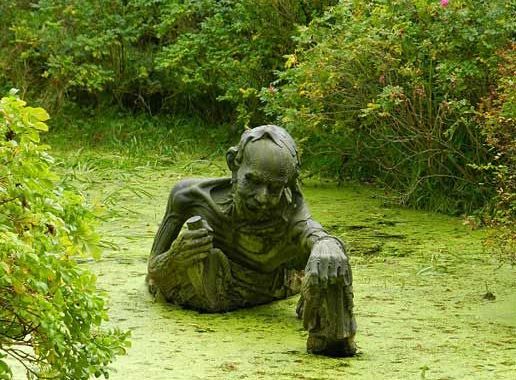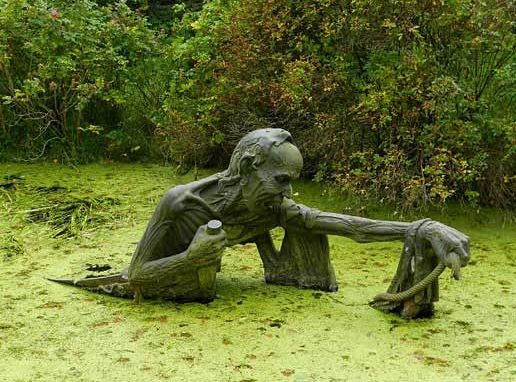Victoria’s Way, located near Roundwood, County Wicklow, Ireland, is a privately owned garden notable for its black granite sculptures. The 9-hectare property includes a number of small lakes and forested areas. A plaque by the entrance says the park is dedicated to cryptographer Alan Turing.
Covering 22 acres, the park includes a series of dancing figures of Ganesh, Shiva, and other Hindu deities. It also includes more bizarre sculptures of a skeletal Buddha-like figure, an enormous disembodied finger, and a sculpture called “The Split Man” which shows a figure ripping itself in two, representing “the mental state of the dysfunctional human.” Intended to represent the spiritual progression to enlightenment, this collection of 14 statues took 20 years to complete. Most of the park’s statues are made of black granite, and range in height from 1.5m to 4.9m.

Death of the Ferryman is one of the statues on exhibit at Victorias Way Indian Sculpture Garden. It is one of the “forest sculptures”, each of which represent various stages of life according to Buddhist religious philosophy. For scale, this statue is about twice life size and sits in a pool of algae covered water.

The sculpture of the Ferryman’s End is a metaphor for the individual who is losing touch with the real world, personal or general. Because the sense of realness and the release of energy (read: enlightenment) resulting from the fusion of ‘this’ with ‘that’, therefore between differences, happens as after-affect of contact (i.e. of touch), loss of connectivity results in increased feelings of un-realness and loss of energy (experienced as depression), which in turn results in the fading of identity (and self-meaning) and increased unhappiness (the latter telling the individual that he or she is failing/dying.

A sign beside the ferryman statue describes the sculptor’s intent:
The ferryman’s craft lies dead in the water. Unable to move, he can no longer reach the ‘other’ shore and touch it. Unable to touch he cannot become real, identified and fully energized (hence joyful). Unmoving, he sinks and dies.
The ferryman’s craft is his capacity to create a difference.
The sculpture of the Ferryman’s End is a metaphor for the individual who is losing touch with the real world, personal or general. Because the sense of realness and the release of energy (read: enlightenment) resulting from the fusion of ‘this’ with ‘that’, therefore between differences, happens as after-affect of contact (i.e. of touch), loss of connectivity results in increased feelings of un-realness and loss of energy (experienced as depression), which in turn results in the fading of identity (and self-meaning) and increased unhappiness (the latter telling the individual that he or she is failing/dying.

The park is owned and maintained by Victor Langheld, who was born in 1940 in Berlin and has lived with a number of different religious orders in Thailand, Japan, and Sri Lanka. A large family inheritance allowed Langheld to spend most of his adult life traveling to spiritual sites in Asia, before going to Ireland and sponsoring the construction of the sculpture park. Mr. Langheld designed most of the sculptures and continues to curate the park and welcome visitors. The park is open to the public during the summer months, with an admission fee for adults.
Lead photo source
